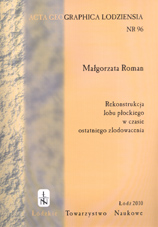Rekonstrukcja lobu płockiego w czasie ostatniego zlodowacenia
Reconstruction of the Płock During the Last Glaciation
Author(s): Małgorzata RomanSubject(s): Cultural Essay, Political Essay, Societal Essay
Published by: Łódzkie Towarzystwo Naukowe
Summary/Abstract: The study pertains the dynamics of the ice sheet, the age and chronology of glacial events in the Płock lobe during the Vistulian (Weichselian) Glaciation. The issue of the presence of the last Scandinavian ice sheet within the Płock Basin has a long history and so far, no agreement has been found as to the number, rank and age of advances as well as to the course of the last glaciation. Complex sedimentological research and luminescence age indices of deposits along with mezostructural analysis of glaciotectonic deformations have been carried out in several-odd exposures. Detailed geological charting has been applied for glaciomarginal zones, the last glacial maximum limit (LGM) and two belts of hillocky landforms apparent in the LGM hinterland, the Czamanin– Otmianowo–Paruszewice (preLGM-1) and Izbica Kujawska–Pagórki Chodeckie–Szewo–Korzeń Królewski (preLGM-2). Spatial distribution of subglacial and ice-marginal landforms were analyzed on the basis of the digital elevation model (DTED2) and also the relief and lithology of the subglacial surface has been reconstructed. There is no evidence that the ice sheet advanced onto the Płock Basin vicinity during the Early and Middle Vistulian. It has been proved that during the last glaciation a singular ice transgression had taken place in the area investigated, which had happened between 22.9 and 18.7 ka BP. The event has been correlated with the Poznań (Brandenburg) Phase of the Main Stadial of the Vistulian Glaciation. The ice advance exceeded the earlier Leszno (Frankfurt) Phase, forming the short-lived Płock lobe and delineated the last glacial maximum (LGM) in central Pola (Korzecznik–Przedecz–Kubłowo–Walentowo–Kamienna–Antoniewo–Sokołów–Osiny– Szczawin–Gąbin–Mijakowo–Goślice–Zągoty). Dynamics of the Płock lobe were influenced by local conditions: topography, subglacial hydrology and ice base thermics. Transgression proceeded with brief standstills along terrain obstacles close to the preLGM-1 and preLGM-2 trains. Such transverse trains, where so far believed to have been recession moraines; they represent, however, overridden push moraines (preLGM-1) or a range of glaciomarginal fans among whom included were older, pre-Vistulian marginal forms (preLGM-2). It was also found that such a transverse large-scale glacial lineation appeared as an effect of a rhythmical building of structures and forms at the front of the fast moving ice sheet. Ice sheet in the Płock lobe featured a warm base system. Only in the marginal part during the LGM the ice base was cold in patches. Dominant in the mechanism of the ice movement, prior to the subglacial channel drainage build-up and stabilising the ice front at the LGM line, was a basal sliding resulting in an apparent growth of ice speed and a pervasive subglacial deformation. It has been proved that the ice travel geometry in the Płock lobe was of a fan character, typical for a distal part of a land-based ice stream.
Journal: Acta Geographica Lodziensia
- Issue Year: 2010
- Issue No: 096
- Page Range: 1-167
- Page Count: 167
- Language: Polish

